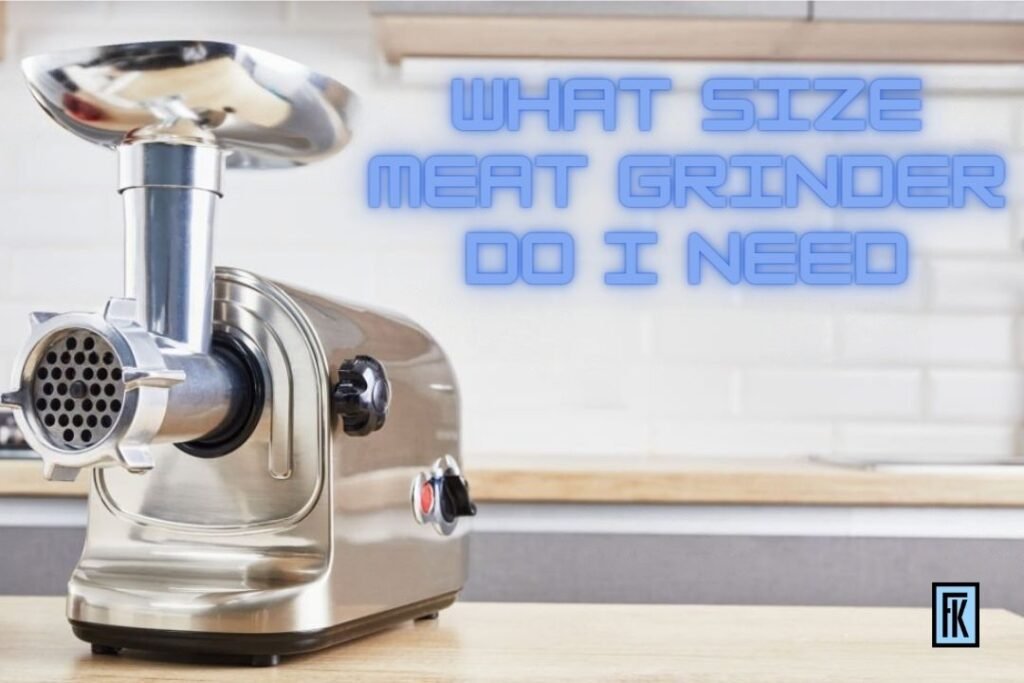
When it comes to efficiency and achieving the desired results in your culinary endeavors thoroughly, a meat grinder is extremely important. The choice of the right size determines efficiency as well as whether you will get the result your heart desires in terms of local cuisine. Today, I’ll help you in making a decision on What Size Meat Grinder Do I Need?
As a meat grinder user, I know how much the meat grinder size matters. And after struggling for the perfect size I finally ended up with the most suitable size of meat grinder. I’ve compiled a list that considers various factors to ensure you get reliable information for choosing what size meat grinder do i need for kitchen.
Your processing requirements will be satisfied effectively if you select the appropriate meat grinder size. It stops the machine from being overworked and also helps you get just the right texture for all sorts of dishes
Table of Contents:
- Why Is Meat Grinder Size Important?
- Understanding the Different Sizes of Meat Grinders.
- Grinder Sizes.
- What Size Meat Grinder Do I Need?
- Assessing Your Grinding Needs.
- General Guidelines for Maintenance.
- Recommendations for Storage and Handling.
- Conclusion.
- FAQ’s.
Let’s explore each aspect in detail, starting with Why Is Meat Grinder Size Important.
Why Is Meat Grinder Size Important?
The size of a meat grinder is important because it has an immediate effect on its capabilities and efficiency. The size of a meat grinder determines how much volume of meat it can process each length of time, and will also affect the texture of what is produced.
Larger grinders are appropriate for bulk processing in commercial settings since they can handle larger amounts of meat. I am assuming that the size question often pops up in your mind: what size meat grinder do I need to speed my grinding process, therefore, the larger grinder size can speed up processing and improve effectiveness all around. Due to their capacity limitations, smaller grinders are more suitable for sporadic use at home.
Furthermore, the texture of the ground meat is a factor that depends to some extent on the size of holes in the grinder plate as well. For the best results when creating sausages or ground meat with texture, use coarser plates with wider holes.
Understanding the Different Sizes of Meat Grinders:
Meat grinders come in different sizes, sorted by the measurement of their plate, and normally range from #5 to #32. The smaller the number, the smaller the grinder. These sizes can be broadly categorized as small, medium, and large.
1. Small Grinders:
Small grinders, such as #5 or #8, are ideal for occasional home use. They are compact, easy to store, and suitable for grinding small quantities of meat. Home cooks who grind meat infrequently or in small batches will find these sizes convenient.
2. Medium Grinders:
Medium-sized grinders, around #10 to #12, strike a balance between home and professional use. They are suitable for those who grind meat more frequently or in larger quantities. Home cooks who prepare substantial batches or experiment with various cuts may find a medium-sized grinder advantageous.
3. Large Grinders:
Large grinders, sized #22 or #32, are designed for professional and commercial use. Such heavy-duty appliances can process large amounts of meat efficiently, so essential in restaurants, butchers or bulk meat processing establishments.
Grinder Sizes:
| Grinder Size Number | Plate Diameter | Hole Diameter | Type of Grind | Ideal for Grinding Meat for |
| #5 | 2-1/8″ | 6mm (1/4″) | Coarse | Sausages such as summer, salami, pepperoni, and snack sticks |
| #8 | 2-3/8″ | 10mm (3/8″) | Coarse / first grind | Chili, chorizo, and linguisa |
| #8 | 2-3/8″ | 4.5mm (3/16″) | Coarse / second grind | Hamburger, Regular sausages |
| #10/12 | 2-3/4″ | 10mm (3/8″) | Coarse / first grind | Chili, chorizo, and linguisa |
| #20/22 | 3-1/4″ | 4.5mm (3/16″) | Coarse / second grind | Hamburger, Regular sausages |
| #20/22 | 3-1/4″ | 3mm (1/8″) | Fine | Hamburger, bologna, hot dogs |
| #20/22 | 3-1/4″ | 12mm (1/2″) | Coarse / first grind | Chili and stewed meats |
| #20/22 | 3-1/4″ | 10mm (3/8″) | Coarse / first grind | Chili, chorizo, and linguisa |
| #20/22 | 3-1/4″ | 6mm (1/4″) | Coarse | Sausages such as summer, salami, pepperoni, and snack sticks |
| #32 | 3-7/8″ | 3mm (1/8″) | Fine | Hamburger, bologna, hot dogs, and jerky |
| #42 | 5 1/16″ | 4mm | Commercial use / coarse | Hamburger, salami, summer sausage, pepperoni, and bratwurst |
Importance of Considering Intended Use and Frequency:
Choosing a meat grinder of the appropriate size is important, and it depends on how you’ll use it and just how often. The frequent grinder needs a medium or large model, while the occasional home cook may get by with something smaller. Matching the grinder size to your specific needs ensures optimal performance and efficiency in the kitchen.
What Size Meat Grinder Do I Need?
Choosing the right size meat grinder size, everything revolves around adjusting your decision to your particular requirements and use designs. Here are some recommendations for different scenarios, along with the pros and cons of each size to empower you in making an informed decision.
1. Occasional Home Use (Small Grinders – #5 or #8):
Recommendation: Opt for a small grinder if you grind meat infrequently or in modest quantities at home.
Pros: Compact, easy to store, and suitable for small batches.
Cons: May struggle with larger quantities or tougher cuts.
2. Regular Home Use (Medium Grinders – #12):
Recommendation: On the off chance that you grind meat all the more regularly or in bigger groups, a medium-sized grinder is great for home cooks.
Pros: Balanced size, suitable for both small and moderate quantities.
Cons: Not as compact as smaller grinders.
3. Professional or Commercial Use (Large Grinders – #22 or #32):
Recommendation: For heavy-duty utilization or large-scale meat grinding, opt for a large-size grinder.
Pros: Handles large volumes efficiently, ideal for professional settings.
Cons: Bulky and may be overkill for casual home cooks.
Consider your grinding needs and frequency to find the perfect fit, ensuring your meat grinder aligns seamlessly with your culinary requirements.
Assessing Your Grinding Needs:
Before selecting a meat grinder, it’s good to check your grinding requirements. Consider the following factors to determine the ideal size for your needs:
Factors to Consider:
- Family Size: For smaller modest families, a compact meat grinder will do the right, while bigger families require a medium-sized meat grinder. Assess your typical batch size to align with your family’s needs it’s the best size for those who are searching for the answer what size meat grinder do I need.
- Types of Meat to Grind: Consider the variety of meats you plan to grind. Tougher cuts may require a more robust grinder, while a smaller one may be adequate for softer meats.
- Quantity of Meat: Think about the volume of meat you’ll be grinding in one session. If you often process large quantities, a larger grinder may save you time and effort.
Tips for Estimating Meat Amounts:
- Portion Sizes: Estimate the typical portion size you prepare in one meal. This helps gauge the quantity of meat you’ll be grinding at once.
- Frequency of Use: Consider how frequently you want to use the meat grinder. Frequent use may warrant a larger size to handle repeated grinding sessions. Therefore, I am putting right answer to the question of what size meat grinder do I need so you will not make mistakes in picking the best option for yourself.
- Special Occasions: If you often host gatherings or special events, factor in the amount of meat needed for these occasions to ensure your grinder can handle increased demand.
Cautiously assessing these elements and assessing your meat grinder necessities, you’ll be better prepared to pick the right size meat grinder that perfectly goes with your culinary requirements.
General Guidelines for Maintenance:
Keeping up with and cleaning your meat grinder is fundamental to guarantee its ideal performance and lifespan. Here are some tips to keep your appliance in top condition:
- Clean your meat grinder thoroughly after each use. Disassemble the parts and wash them with warm, soapy water. Ensure all meat residue is removed to prevent bacterial growth.
- It’s essential to know how to clean a meat grinder properly.
- Regularly inspect the blades and grinding plates for any signs of damage or dullness. If you notice wear, consider replacing these components to maintain efficient grinding.
- Learn from our guide how to sharpen meat grinder blades to prolong their lifespan and ensure optimal performance.
- Apply food-grade lubricant to the moving parts of your grinder, such as the screw and blade, to prevent friction and ensure smooth operation.
- Apply food-grade lubricant to the moving parts of your meat grinder, like the screw and blades, to prevent friction & get smooth activity.
Recommendations for Storage and Handling:
- After cleaning, ensure all components are completely dry before storing your meat grinder. Moisture can lead to rust, affecting the grinder’s performance.
- If possible, disassemble your grinder for storage. This saves space as well as diminishes the possibility of parts rubbing against one another and wearing out after some time.
- Find a cool, dry location to store your meat grinder. Stay away from areas with extreme temperatures or high humidity, as these can harm the metal parts.
Conclusion:
I hope I covered all your questions regarding What Size Meat Grinder Do I Need?
By selecting the right meat grinder size, you can achieve the best result on your meat grinding undertakings. By understanding the various sizes accessible, surveying your grinding necessities, and considering additional features, you can easily pick the right size meat grinder that suits your grinding requirements. Ensure to appropriately keep up with and care for your meat grinder to drag out its life expectancy and keep getting a charge out of newly ground meat for a long time.
Or if you looking for meat grinder read our guide on best meat grinder for home use.
Or for knowing working principle of meat grinder check how does a meat grinder work.
FAQ’s;
1. How do you size a meat grinder?
To size a meat grinder, consider the grinder’s plate diameter, which ranges from #5 to #32. Choose a meat grinder based on your crushing requirements —smaller for occasional home use, medium for regular home use, and larger for professional or commercial use.
2. What size grinder for hamburger meat?
For hamburger meat, a medium-sized grinder, commonly #8 or #10, is suitable. These sizes strike a balance, offering enough power and capacity for efficient grinding at home. Or you can check on above guide what size meat grinder do i need.
3. What is the difference between a 10 and 12 meat grinder?
The difference between a #10 and #12 meat grinder lies in the plate diameter. A #12 grinder has a larger plate diameter than a #10, providing more capacity and power. This makes #12 grinders better suited for larger batches and tougher cuts.
4. What does #8 meat grinder mean?
The term ” #8 meat grinder” refers to the size of the grinder, specifically the plate diameter. In this case, it is approximately 2 3/8 inches. #8 grinders are mid-sized and are suitable for regular home use, offering a good balance of power and capacity.









